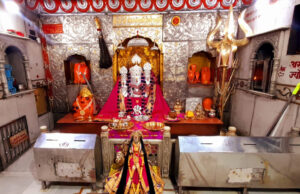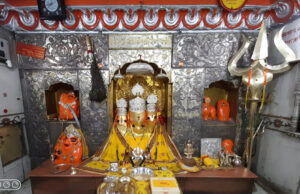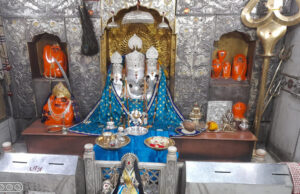About Maa Baglamukhi
Baglamukhi or Bagalā (Sanskrit: बगलामुखी)
Maa Baglamukhi
Baglamukhi or Bagalā (Sanskrit: बगलामुखी) is one of the mahavidyas (great wisdom/science), a group of ten Tantrik deities in Hinduism.
Maa Baglamukhi is a revered Hindu goddess, considered to be the eighth Mahavidya (Great Wisdom) in the Dasha Mahavidya tradition. She is known as the deity of power, protection, and victory over obstacles. “Bagla” means “bridle” or “rein,” while “Mukhi” means “faced” or “facing.” The name Baglamukhi symbolizes her power to restrain or control negative forces and enemies.

Iconography
Another interpretation translates her name as “Kalyani”. In Kubjika Tantra there is a reference to yet another interpretation of the meaning of the name ‘Bagala’. In the initial chapter of the text, there is a verse – ‘Bakare Baruni Devi Gakare Siddhida Smrita. Lakare Prithivi Chaiba Chaitanya Prakrirtita’ (‘Ba’, the first letter of the name – ‘Bagala’, means ‘Baruni’ or ‘She Who is filled with the intoxicating mood to vanquish the demon’. ‘Ga’, the second letter, means ‘She Who grants all kinds of divine powers or siddhis and successes to human beings’. ‘La’, the third letter, means ‘She Who is the foundation of all kinds of sustaining powers in the world like the earth and is Consciousness Herself’.
Two descriptions of the goddess are found in various texts: the Dwi-Bhuja (two-handed), and the Chaturbhuja (four-handed). The Dwi-Bhuja depiction is the more common and is described as the “Soumya” or milder form. She holds a club in her right hand with which she beats a demon, while pulling his tongue out with her left hand. This image is sometimes interpreted as an exhibition of stambhana, the power to stun or paralyse an enemy into silence. This is one of the boons for which Bagalamukhi’s devotees worship her. Other Mahavidya goddesses are also said to represent similar powers useful for defeating enemies, to be invoked by their worshippers through various rituals.
Bagalamukhi is also called Pitambaradevi, Shatrubuddhivinashini and Brahmastra Roopini and she turns each thing into its opposite.
The Tantrasara describes her iconography: Bagalamukhi sits in a golden throne in the midst of an ocean in an altar. Her complexion is yellow (golden). Clad in yellow clothes, she is adorned by a garland of yellow flowers and decked with yellow (golden) ornaments. She pulls the tongue of a demon by her left hand, while raising the right hand to strike him with a club.[4] Another description says that she has four arms and a third eye. A yellow crescent moon adorns her forehead.
Though generally depicted with a human head, the goddess is sometimes described to have a head of a crane and sometimes depicted ridding a crane. Sometimes, she is described associated with other birds: having a duck-head or a nose of a parrot.
Etymology And Other Epithets
Kinsley translates Bagalamukhi as “she who has the face of a crane”. Bagalamukhi is rarely depicted with a crane-head or with cranes. Kinsley believes that the crane’s behaviour of standing still to catch prey is reflective of the occult powers bestowed by the goddess.
Another interpretation suggests that Baglamukhi is a corruption of the word Valgamukhi; valga means “bridle” or “bit”. Like the bridle or bit – placed in the mouth – is used to direct a horse, Bagalamukhi gives the supernatural power of control over one’s foes. In this context, Bagalamukhi is she “whose face has the power to control or conquer”.
Another etymology suggests that valga means “to paralyze” and symbolizes the power of stambhana, “paralysis” that the goddess is said to grant; this theory seems questionable to Kinsley.
Bagalamukhi is known by the popular epithet Pitambara-devi or Pitambari, “she who wears yellow clothes”. The iconography and worship rituals repeatedly refer to the yellow colour.
Legend
In the Satya Yuga (the first epoch in Hindu cosmology), a great storm started destroying Creation. The god Vishnu was disturbed and performed austerities to appease the goddess Parvati on shore of Haridra Sarovar, the lake of turmeric. Pleased with Vishnu, the goddess appeared and brought forth her manifestation Bagalamukhi from the lake. Bagalamukhi calmed the storm, restoring order in the universe.
Another tale records that a demon named Madan acquired Vak-siddhi, by which whatever he said came true. He misused it to trouble humans and murder people. The gods beseeched Bagalamukhi. The goddess grabbed the demon’s tongue and immobilized his power. Madan requested the goddess that he be worshipped with her; the goddess granted him this boon, before slaying him.
Symbolism And Associations
Bagalamukhi is strongly associated with the yellow colour. She dresses in yellow clothes and ornaments. Various texts describe her affinity to the colour; yellow is an integral part of her worship rituals. Bagalamukhi is propitiated with yellow offerings by devotees dressed in yellow, seated on a yellow cloth. Yellow turmeric bead rosary are used in her japa (repetition) of her names or mantra (invocation). The colour yellow is linked to the Sun, gold, the earth, grain and fire, signifying auspiciousness, bountifulness and purity. The yellow turmeric is associated with marriage.[8] This is why goddess Bagalamukhi is also known as Pitambhara devi.
Bagalamukhi is praised as the giver of supernatural powers (siddhis) or magical powers (riddhis).
In ‘Bagalamukhistotratram’, a part of ‘Rudrayamala’ (a famous Tantra work), there are hymns in praise of the powers of Goddess Bagalamukhi – “Vadi Mukati Rankati Kshitipatirvaishwanarah Sheetati Krodhi Samyati Durjanah Sujanati Khsipranugah Khanjati. Garvi Khanjati Sarvaviccha Jarati Tvanmantrinaamantritah Srinitye Baglamukhi Pratidinam Tubhyam Namah “(By the effect of Your Mantra good conversationalists become speechless; rich become beggars; devastating fire gets cooled. The anger of the angry person is removed; an evil minded person becomes good. The quick moving person becomes crippled. The conceit of the conceited person is reduced. Knowledgeable person nearly becomes a fool. Salutations to the compassionate Bagalamukhi!)



